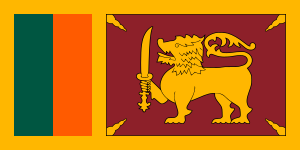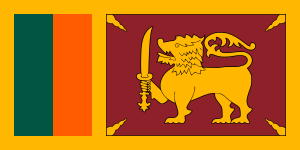Flag of Sri Lanka facts for kids
 |
|
| Use | Civil and state flag, civil ensign |
|---|---|
| Proportion | 1:2 |
| Adopted | May 22, 1972 |
| Design | Dark red rectangular panel bordered yellow containing a yellow lion passant holding a sword upright in its right fore paw, and four pipul leaves, one in each corner, and next to the hoist two vertical stripes, green and orange, also bordered yellow together. |

Variant flag of Sri Lanka
|
|
| Use | Naval ensign |
| Proportion | 1:2 |
| Adopted | 1972 |
| Design | White with the national flag in the canton. |
The Flag of Sri Lanka is also known as the Lion Flag. It is a very important symbol for the country. This flag shows a golden lion holding a sword. The lion stands on a dark red background. There are four golden bo leaves in each corner of this background.
A bright yellow border goes all around the flag. On the left side, there are two vertical stripes. One stripe is green, and the other is orange. The orange stripe is closer to the lion. This flag was officially adopted in 1950. This happened after a special group suggested its design. The group was set up by Sri Lanka's first Prime Minister, D.S. Senanayake.
Contents
Understanding the Flag's Design
The Sri Lankan flag has many parts, and each part has a special meaning.
The Golden Lion
The golden lion on the flag is a very old symbol. It represents the Sinhalese people. They are the largest ethnic group in Sri Lanka. The lion shows bravery and strength. It also stands for the country's heritage.
The Sword in the Lion's Paw
The sword held by the lion is a symbol of power. It also represents the nation's independence. It shows that Sri Lanka is a free country. The sword reminds everyone of the country's fight for freedom.
The Four Bo Leaves
The four golden bo leaves are found in each corner of the red background. These leaves come from the sacred Bo tree. This tree is very important in Buddhism. The leaves represent four important Buddhist values:
- Metta (kindness)
- Karuna (compassion)
- Mudita (joy)
- Upekkha (peacefulness)
These values are important for the people of Sri Lanka.
The Stripes and Border
The two vertical stripes on the left side of the flag also have meanings:
- The orange stripe represents the Sri Lankan Tamils. They are another major ethnic group in the country.
- The green stripe stands for the Sri Lankan Moors. This group includes the Muslim community.
The yellow border around the flag shows unity. It means that all the different groups in Sri Lanka live together in harmony.
History of the Sri Lankan Flag
The design of the Sri Lankan flag has changed over time.
Early Flags
Before 1948, Sri Lanka was known as Ceylon. It was under British rule. The flags used during this time were different. When Ceylon became independent in 1948, it needed a new national flag.
The 1950 Design
The current design of the Lion Flag was adopted in 1950. A special committee was formed to create it. This committee included people from different communities. They wanted a flag that represented everyone in the country. The design combined traditional symbols with new elements.
Changes in 1972
In 1972, Ceylon became the Republic of Sri Lanka. The flag was slightly updated. The four bo leaves were added to the corners. This change made the flag even more meaningful. It highlighted the country's Buddhist heritage.
Images for kids
-
Flown at the Embassy in Warsaw
-
Displayed outside a stadium, in Leeds, UK
-
Mountaineer Jayanthi Kuru-Utumpala with Sri Lankan flag atop Mount Everest
-
Hung vertically, along a street in Malaysia
-
Displayed along other flags, in London
See also
 In Spanish: Bandera de Sri Lanka para niños
In Spanish: Bandera de Sri Lanka para niños









